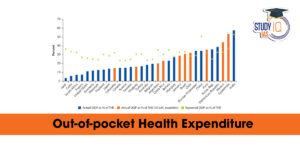Table of Contents
Context
- The Union Budget 2025-26 sets the stage for India’s economic expansion, projecting GDP growth from $3.7 trillion (2023-24) to $7 trillion (2030-31).
- Achieving this goal requires strong fiscal and monetary policies, infrastructure development, and efficient capital allocation.
Challenges for India’s Economic Growth
- Low Private Sector Investment: Private sector investment-to-operating cash flow has dropped from 114% (2008-09) to 56% (2023-24).
- Reasons: Uncertainty in future demand and geopolitical risks.
- Limited Credit Access for MSMEs: Large corporates access bank credit, equity, and bond markets, while MSMEs face credit shortages.
- Household savings shifting to mutual funds and pension schemes, reducing banks’ credit availability.
- Regulatory Constraints on Banking Liquidity: 30% of bank deposits are locked in regulatory preemptions (SLR: 26%, CRR: 4%).
- High Liquidity Coverage Ratio (LCR) requirements further reduce lendable resources.
- Banks invest ₹13 trillion in G-Secs out of ₹40 trillion deposit inflows, limiting funds for lending.
- Outdated Priority Sector Lending (PSL) Framework: PSL requirement at 40% does not align with current economic priorities.
- Pricing does not reflect credit risk, affecting bank profitability.
- Lower Credit Growth than Nominal GDP Growth: Credit growth lagging behind GDP growth, impacting financing for expansion.
- Over-regulation on interest rates and clean lending reduces financial inclusion.
- Rupee Volatility and Liquidity Impact: Defending the rupee against a strong dollar reduces market liquidity.
- Leads to an overvalued rupee without effectively strengthening forex reserves.
- High Bank Tech Investment with Low Returns: Indian banks spend 5% of annual expenditure on technology.
- Global comparison: Tech investment in banking at 9%, while revenue growth is only 4%.
- Free UPI transactions increase operational costs without revenue generation.
- Underdeveloped Derivatives Market: India’s government bond market share in global indices: 3% (Indonesia: 14.5%).
- Cash market liquidity is adequate, but the derivatives market remains weak.
What Needs to Be Done?
- Boost Private Sector Investment: Incentivize corporate investment through tax benefits and ease of doing business reforms.
- Strengthen demand confidence through policy stability and infrastructure growth.
- Improve Credit Access for MSMEs: Encourage risk-based pricing and cash-flow-based lending instead of collateral-heavy lending.
- Strengthen fintech partnerships to expand MSME credit reach.
- Reduce Regulatory Preemptions on Banking Liquidity: Reassess the need for both SLR and LCR; globally, only LCR is used.
- Allow banks more flexibility in investing funds instead of excessive G-Sec purchases.
- Revamp Priority Sector Lending (PSL): Update PSL guidelines to reflect changes in GDP structure and economic needs.
- Ensure PSL pricing reflects credit risks, improving bank profitability.
- Increase Credit Growth to Match GDP Growth: Expand financial inclusion with AI-driven risk assessment and digital lending models.
- Reduce regulatory burdens on interest rates and clean lending.
- Manage Rupee Stability Without Reducing Liquidity: Avoid excessive intervention in currency markets; instead, focus on long-term forex management.
- Strengthen domestic investment avenues to reduce dependence on external inflows.
- Ensure Sustainable Bank Technology Investment: Explore small transaction fees on UPI to compensate for network costs.
- Implement global best practices for cost-recovery models.
- Develop India’s Bond and Derivatives Market: Ease regulations to increase India’s global bond market share.


 Out-of-Pocket Health Expenditure, Reason...
Out-of-Pocket Health Expenditure, Reason...
 Treasury Bills (T-bills): RBI Cuts Holdi...
Treasury Bills (T-bills): RBI Cuts Holdi...
 Fisheries Sector in India, Current Statu...
Fisheries Sector in India, Current Statu...

























